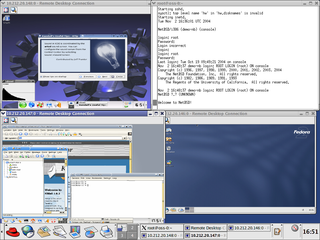Introduction
It is commonly known that modern day PCs are extremely powerful and have substantial excess CPU processing power. In fact, most desktop applications do not use the multi-core capabilities of today's CPUs. When an application is launched it runs on the first core, and when a second application is launched, it continues to run on the first core. That process continues (with the second and subsequent cores basically idling) until the original core gets very busy. At that point, the operating system tells the new applications to run on the second and subsequent cores.
Server based computing
Server based computing has been around for a long time specifically to take advantage of this excess CPU power and allow multiple users to share it. It started in the 1950s and 1960s with batch processing and has taken its current day form with Citrix and Terminal Services. nComputing and Microsoft Multipoint are current iterations of the same thin client technology. The typical problem with this type of system is that it is dependent upon one operating system and one set of applications and there are many software titles that are not allowed to be shared among multiple users. That means that the first user of a program will get access but subsequent users will not. Another problem is that the video is not delivered via native means. It is usually delivered via network traffic and must rely upon the "packetizing" methods employed using TCP-IP. This means that video does not run very well, especially if the network traffic is busy.
Server virtualization
Virtualization can solve some of these problems. Virtualization is a method by which the "guest" operating system runs on top of, while being separated from the "bare metal" hardware. This means that multiple "guest" operating systems can be run, solving the problem of single user applications not being able to be launched for multiple, concurrent users. Xen used in conjunction with Citrix, or VMware used in conjunction with Microsoft Terminal Services are examples of this technology. Although it is still server based computing and relies upon a "thin" or a "fat" client to display the video output of the session, it allows multiple users to launch the same application because they are launching totally different instances of the same application, in different "guest" operating systems. But the issue still remains that video does not run very well because it still relies upon the network to deliver video. It is also extremely complicated to install and maintain, requiring extra training and knowledge.
Multiseat desktop virtualization differences
Multiseat desktop virtualization is an entirely new methodology which combines the cost saving benefits and ease of maintenance of server based computing, the time savings of hardware agnostic cloning, and the capabilities of desktop virtualization, with the performance capabilities of real PC functionality. It takes advantage of this fact to enable ordinary users to install a multiseat PC giving 2 "seats" with a dual-core CPU or 4 "seats" with a quad-core CPU. The operating system of this PC is initially installed just like a regular PC. Regular PC users can install and use this type of product without having to install servers, or know how to manage complicated, server based computing or server based virtualization products. It has the combined benefits of a Type 1 hypervisor and a Type 2 hypervisor virtual machine. It does this with the efficiency of a Type 1 hypervisor while maintaining the portability of a Type 2 hypervisor.

In computer networking, a thin client is a simple (low-performance) computer that has been optimized for establishing a remote connection with a server-based computing environment. They are sometimes known as network computers, or in their simplest form as zero clients. The server does most of the work, which can include launching software programs, performing calculations, and storing data. This contrasts with a rich client or a conventional personal computer; the former is also intended for working in a client–server model but has significant local processing power, while the latter aims to perform its function mostly locally.

Citrix Systems, Inc. is an American multinational cloud computing and virtualization technology company that provides server, application and desktop virtualization, networking, software as a service (SaaS), and cloud computing technologies. Citrix products were claimed to be in use by over 400,000 clients worldwide, including 99% of the Fortune 100, and 98% of the Fortune 500.

Xen is a type-1 hypervisor, providing services that allow multiple computer operating systems to execute on the same computer hardware concurrently. It was originally developed by the University of Cambridge Computer Laboratory and is now being developed by the Linux Foundation with support from Intel, Citrix, Arm Ltd, Huawei, AWS, Alibaba Cloud, AMD, Bitdefender and epam.
A hypervisor is a type of computer software, firmware or hardware that creates and runs virtual machines. A computer on which a hypervisor runs one or more virtual machines is called a host machine, and each virtual machine is called a guest machine. The hypervisor presents the guest operating systems with a virtual operating platform and manages the execution of the guest operating systems. Unlike an emulator, the guest executes most instructions on the native hardware. Multiple instances of a variety of operating systems may share the virtualized hardware resources: for example, Linux, Windows, and macOS instances can all run on a single physical x86 machine. This contrasts with operating-system–level virtualization, where all instances must share a single kernel, though the guest operating systems can differ in user space, such as different Linux distributions with the same kernel.
A blade PC is a form of client or personal computer (PC). In conjunction with a client access device on a user's desk, the supporting blade PC is typically housed in a rack enclosure, usually in a datacenter or specialised environment. Together, they accomplish many of the same functions of a traditional PC, but they also take advantage of many of the architectural achievements pioneered by blade servers.

A multiseat, multi-station or multiterminal system is a single computer which supports multiple independent local users at the same time.
Application virtualization is a software technology that encapsulates computer programs from the underlying operating system on which they are executed. A fully virtualized application is not installed in the traditional sense, although it is still executed as if it were. The application behaves at runtime like it is directly interfacing with the original operating system and all the resources managed by it, but can be isolated or sandboxed to varying degrees.
The following is a timeline of virtualization development. In computing, virtualization is the use of a computer to simulate another computer. Through virtualization, a host simulates a guest by exposing virtual hardware devices, which may be done through software or by allowing access to a physical device connected to the machine.
Desktop virtualization is a software technology that separates the desktop environment and associated application software from the physical client device that is used to access it.

Microsoft Hyper-V, codenamed Viridian, and briefly known before its release as Windows Server Virtualization, is a native hypervisor; it can create virtual machines on x86-64 systems running Windows. Starting with Windows 8, Hyper-V superseded Windows Virtual PC as the hardware virtualization component of the client editions of Windows NT. A server computer running Hyper-V can be configured to expose individual virtual machines to one or more networks. Hyper-V was first released with Windows Server 2008, and has been available without additional charge since Windows Server 2012 and Windows 8. A standalone Windows Hyper-V Server is free, but has a command-line interface only. The last version of free Hyper-V Server is Hyper-V Server 2019, which is based on Windows Server 2019.
In computing, virtualization or virtualisation is the act of creating a virtual version of something at the same abstraction level, including virtual computer hardware platforms, storage devices, and computer network resources.
An embedded hypervisor is a hypervisor that supports the requirements of embedded systems.
A Nirvana Phone was a marketing phrase coined by Citrix for a smartphone that could be docked with external displays and keyboards to create an alternative desktop or laptop computer system. It was to define a new category of mobile device with a capability beyond a conventional smartphone computer. The NirvanaPhone provides the processor, storage media, display adapter, communication channels, and operating system. The docking station provides power, and connectivity. To be useful the NirvanaPhone differs from a simple smartphone by having significant processing power, video output at high resolution, plus keyboard and mouse input. A smartphone is generally accepted as a device that has both mobile phone capability as well as an operating system that can run applications such as email, web browser, media player and personal organizers. The NirvanaPhone adds external monitor capability which could be a computer monitor, an HDTV, or a video projector. The dock could be a cradle, cable or a wireless connection. This allows the NirvanaPhone to run applications that can utilize a full-sized display for better readability or collaboration. Or in combination with a keyboard and mouse, perhaps using Bluetooth, the NirvanaPhone could act as a thin client connected to a virtual desktop for business use.
XenClient is a discontinued desktop virtualization product developed by Citrix that runs virtual desktops on endpoint devices. The product reached end of-life in December 2016. Desktops are run locally, without hosting applications or the operating system in a datacenter. It consists of a Type-1 Xen client hypervisor and a management server, which provides features such as centralized provisioning, patching, updating, monitoring, policy controls, and de-provisioning. It enforces security through features including AES-256 full disk encryption, VM isolation, remote kill, lockout, USB filtering, and VLAN tagging. XenClient supports use cases such as disconnected operation on laptops, limited connectivity environments, and other use cases where use of local execution is desired and centralized management is required.
Wanova, Inc, headquartered in San Jose, California, provides software to help IT organizations manage, support and protect data on desktop and laptop computers. Wanova's primary product, Wanova Mirage, was designed as an alternative to server-hosted desktop virtualization technologies.

Wyse Technology, often shortened to Wyse, was an independent American manufacturer of cloud computing systems. As of 2012, Wyse is a subsidiary of Dell. Wyse are best remembered for their video terminal line introduced in the 1980s, which competed with the market-leading Digital. They also had a successful line of IBM PC compatible workstations in the mid-to-late 1980s. But starting late in the decade, Wyse were outcompeted by companies such as eventual parent Dell. Current products include thin client hardware and software as well as desktop virtualization solutions. Other products include cloud software-supporting desktop computers, laptops, and mobile devices. Dell Cloud Client Computing is partnered with IT vendors such as Citrix, IBM, Microsoft, and VMware.
Founded by Alex Vasilevsky, Virtual Computer was a venture-backed software company in the Boston area that produces desktop virtualization products, which combine centralized management with local execution on a hypervisor running on PCs. By running the workload on the PC, Virtual Computer enables companies to have centralized management without servers, storage, and networking required for server-hosted VDI.
In computing, a system virtual machine is a virtual machine (VM) that provides a complete system platform and supports the execution of a complete operating system (OS). These usually emulate an existing architecture, and are built with the purpose of either providing a platform to run programs where the real hardware is not available for use, or of having multiple instances of virtual machines leading to more efficient use of computing resources, both in terms of energy consumption and cost effectiveness, or both. A VM was originally defined by Popek and Goldberg as "an efficient, isolated duplicate of a real machine".
Citrix Virtual Apps is an application virtualization software produced by Citrix Systems that allows Windows applications to be accessed via individual devices from a shared server or cloud system.
Citrix Virtual Desktops is a desktop virtualization product.





